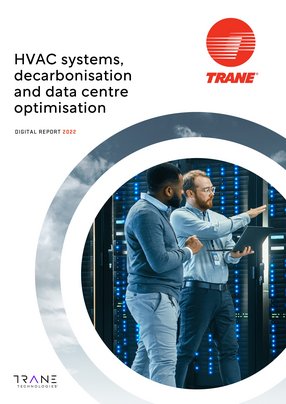HVAC systems, decarbonisation and data centre optimisation
As far as sustainability pledges go, Trane Technologies’ is amongst the most impressive.
With commitments including reducing one billion metric tonnes of carbon emissions from its customers’ footprint by 2030, the company is definitely here to rock the boat. And, for a rapidly expanding sector that is completely dependent on electricity, this optimism and pioneering spirit are both very welcome traits.
Trane Technologies takes a distinctly bold approach to sustainability, not only making it a core part of its company identity, but fixing its sights on being a flag-bearing market leader.
“Our aspirations are to make sure that we're always a step ahead of where the industry is going… my goal is to increase our pace and speed, to get us to a point where we are starting to future-proof our business and lead the market into those future solutions,” explained Miles Auvil, the Global Vertical Market Leader for Data Centers at Trane Commercial.
Quite rightly, the entire data centre sector is prioritising the concept of ‘future-proofing’. It’s not enough to build dependable, efficient services – we also need to ensure that the solutions we build now are investments that can continue into the future.
However, is it actually possible for data centres to decarbonise at the same pace as the sector’s growth? Auvil certainly believes so.
The three stages of decarbonisation
Decarbonisation is – especially in the data centre sector – a process that requires multiple steps, a nuanced analysis and a long-term focus. For Auvil, it’s best outlined in three stages.
“Decarbonisation is a natural journey that we take with our customers, the first step being optimisation. That really plays a big part, not only in existing builds, but also in designing new builds.
“What I mean by that is that a lot of our customers have a large, ageing fleet of data centres – many in the hundreds – and a lot have done what I would say is the easy, simple payback work of energy-efficient upgrades,” Auvil comments.
Trane Technologies encourages its customers to see that throwing money at the problem isn't always the best way to achieve a solution.
“We're taking the approach that there is more to be done and showing them that there are other ways of achieving energy efficiency, without capital-intensive projects. So, we look at things that can be fixed possibly on the same day that we visit and do the assessment via a concept called retro-commissioning.”
“We also look at ways that we can provide some of these solutions as a service, with funding from ESG investors.
“That’s the strategy for existing data centres. For new builds, the optimisation perspective prioritises efficient systems and continues to push the leading edge.”
The second decarbonisation step, Auvil outlines, is electrification and, specifically, the electrification of heat.
“As we increase temperatures and data centres, the wasted heat coming out of these facilities is becoming more valuable to our customers.
“In Europe, specifically in the Nordics and Denmark, you'll see that there are several data centres with chillers that leverage heat recovery or heat reuse,” Auvil explains.
“They take some of that waste heat, and apply it to heating buildings or heating district systems. That hasn't been as well adopted here in North America. But, because the ramp up of valuable heat coming out of the data centres is continuing to increase, it is becoming increasingly attractive for industrial manufacturing enterprises where process heating is required, as well as domestic hot water applications for large condos or apartment buildings.”
The last category is broader, and encompasses decarbonisation as a whole. For that, heating, ventilation and air conditioning (HVAC) plays a pivotal role.
Heating, ventilation and air conditioning - its role in the wider sustainability picture
For data centres’ sustainability strategies, HVAC systems are arguably the factors that hold the most ‘make or break’ potential.
“The HVAC systems consume 30 to 40% of the overall energy within a data centre facility. It's the single largest category and has the greatest room for efficiency improvements,” Auvil comments.
When it comes to HVAC, there are three key stages to data centre decarbonisation: water consumption, energy efficiency and refrigerants.
Firstly, the current climate crisis is driving huge changes in the industry’s use of water cooling solutions.
“We're seeing global and domestic water shortages, and some extreme droughts. So, the industry has made a very clear signal that they want to get away from evaporative cooling, which can consume millions of gallons in a month,” Auvil explains.
“A large part of what we're starting to provide more for our customers is air-cooled chillers, which operate on a closed loop and have zero water consumption. There has been a massive shift in the market over the last year or two. We believe that will be a trend we'll see for many years, assuming we're going to stay in drought status across many regions of the world and here in North America.”
Another challenging aspect of HVAC is the fact that it is one of the largest energy consumers in the data centre environment. So, a primary focus for Trane Technologies is looking at ways to improve the consumption and energy efficiency of these systems.
“This can be done through a number of ways. In existing facilities, we can optimise the older systems that are there, and in new facilities, we can design the most energy-efficient chillers and solutions for our customers, so that they can reduce that energy footprint.”
The third pillar revolves around the types of refrigerants used.
“Obviously, the HVAC world is heavily dependent on synthesised and chemical-based refrigerants, a lot of which have had high global warming potential signatures. So the industry is working to advance the adoption of newer, low-GWP refrigerants as fast as possible, and as responsibly as we can.”
“We use a large pool of refrigerant manufacturers – everyone from Honeywell to Chemours – and working with them hand in hand enables us to both improve the efficiency of our products and reduce the greenhouse gas emissions of the refrigerants that we choose to use,” explains Auvil.
“Those partnerships are critical, especially in today's environment of supply chain challenges.”
The support of ESG investors and Trane Technologies’ partners
Data centre sustainability standards extend far beyond the immediate sector. It's a priority for companies spanning industries across the globe. As a result, ESG investment funds are increasingly funding green data centre projects.
“It's interesting. ESG investors want to invest, period. They have a lot of capital available, and they see these projects as being highly profitable.
“But, from a data centre-specific perspective, they like data centres because the electrical load is a very stable, predictable load for energy modelling. And that gives investors a very high level of confidence when making investments around potential energy savings and operational savings; it becomes a safer investment, from their perspective.”
Trane Technologies also works with a number of trusted partners. These include the marketing specialists Intersport, and Rosie Labs, the latter of which has enabled Trane to get in front of the right audiences and unlock the full potential within the data centre market.
Auvil explains how Trane’s partnerships help the company to stay nimble, ensuring that it is always at the top of the technology landscape and scanning game.
Trane also works with ESG investors, including Brookfield, partnerships that enable them to “access customers who may not otherwise have capital to perform some of these sustainability and decarbonisation projects”.
These partnerships are essentially bringing money to the table, providing savings to the client and executing projects that may otherwise have been put on hold, as the capital may otherwise have been preserved for building new facilities, rather than renovating existing ones.
“This model enables us to give them capital to go and tackle their older facilities, where you can have the greatest decarbonisation impact.”
Data centre decarbonisation - a pipe dream, or the next step?
There is no doubt that the demand for data centres is increasing, and the pace is accelerating at a pace that, for many, is unprecedented.
So, given this rapidity of growth, is an effective degree of decarbonisation even possible?
“It is absolutely possible. Even a year ago, I would've never used the word decarbonise when talking about a data centre. But, in the last six months, the concept has really grabbed traction,” Auvil states.
“A lot of people immediately assume electrification of heat is the only way you decarbonise, but that is highly inaccurate.”
“Optimising the facilities is still meaningful, especially anything that's older than five or ten years. And, globally, there still is a large fleet of those sites.”
Auvil explains how HVAC systems form a pivotal part of this ongoing process.
“There's a desire in the industry to not just look at the low-hanging fruit in the optimised category, but to understand the GWP level of refrigerants. A highly, highly valued topic within our customer base right now is their approach to refrigerant management. And the last piece of it is going to be the developmental aspect of the reuse of these facilities’ waste heat.”
“Heat resuse has been adopted in a small way in Europe, but we expect that to change drastically. As this industry moves towards using immersion or direct liquid cooling, this will have a profound impact on the temperatures coming out of the data centre and make them highly monetisable when it comes to reusing that heat elsewhere in adjacent buildings, campuses, or districts.”





